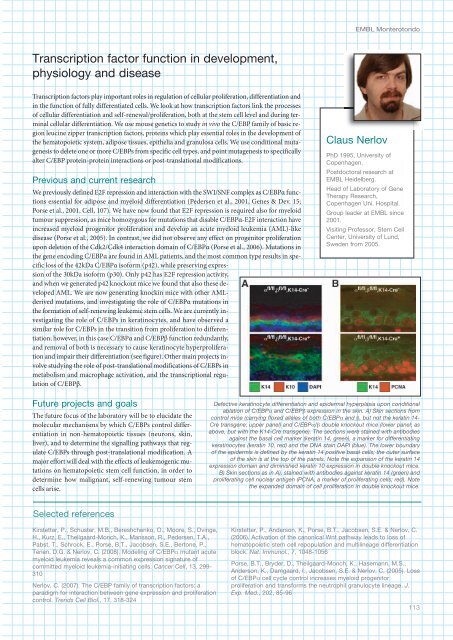You also want an ePaper? Increase the reach of your titles
YUMPU automatically turns print PDFs into web optimized ePapers that Google loves.
<strong>EMBL</strong> Monterotondo<br />
Transcription factor function in development,<br />
physiology and disease<br />
Transcription factors play important roles in regulation of cellular proliferation, differentiation and<br />
in the function of fully differentiated cells. We look at how transcription factors link the processes<br />
of cellular differentiation and self-renewal/proliferation, both at the stem cell level and during terminal<br />
cellular differentiation. We use mouse genetics to study in vivo the C/EBP family of basic region<br />
leucine zipper transcription factors, proteins which play essential roles in the development of<br />
the hematopoietic system, adipose tissues, epithelia and granulosa cells. We use conditional mutagenesis<br />
to delete one or more C/EBPs from specific cell types, and point mutagenesis to specifically<br />
alter C/EBP protein-protein interactions or post-translational modifications.<br />
Previous and current research<br />
We previously defined E2F repression and interaction with the SWI/SNF complex as C/EBPα functions<br />
essential for adipose and myeloid differentiation (Pedersen et al., 2001, Genes & Dev. 15;<br />
Porse et al., 2001, Cell, 107). We have now found that E2F repression is required also for myeloid<br />
tumour suppression, as mice homozygous for mutations that disable C/EBPα-E2F interaction have<br />
increased myeloid progenitor proliferation and develop an acute myeloid leukemia (AML)-like<br />
disease (Porse et al., 2005). In contrast, we did not observe any effect on progenitor proliferation<br />
upon deletion of the Cdk2/Cdk4 interaction domain of C/EBPα (Porse et al., 2006). Mutations in<br />
the gene encoding C/EBPα are found in AML patients, and the most common type results in specific<br />
loss of the 42kDa C/EBPα isoform (p42), while preserving expression<br />
of the 30kDa isoform (p30). Only p42 has E2F repression activity,<br />
and when we generated p42 knockout mice we found that also these developed<br />
AML. We are now generating knockin mice with other AMLderived<br />
mutations, and investigating the role of C/EBPα mutations in<br />
the formation of self-renewing leukemic stem cells. We are currently investigating<br />
the role of C/EBPs in keratinocytes, and have observed a<br />
similar role for C/EBPs in the transition from proliferation to differentiation;<br />
however, in this case C/EBPα and C/EBPβ function redundantly,<br />
and removal of both is necessary to cause keratinocyte hyperproliferation<br />
and impair their differentiation (see figure). Other main projects involve<br />
studying the role of post-translational modifications of C/EBPs in<br />
metabolism and macrophage activation, and the transcriptional regulation<br />
of C/EBPβ.<br />
Claus Nerlov<br />
PhD 1995, University of<br />
Copenhagen.<br />
Postdoctoral research at<br />
<strong>EMBL</strong> Heidelberg.<br />
Head of Laboratory of Gene<br />
Therapy Research,<br />
Copenhagen Uni. Hospital.<br />
Group leader at <strong>EMBL</strong> since<br />
2001.<br />
Visiting Professor, Stem Cell<br />
Center, University of Lund,<br />
Sweden from 2005.<br />
Future projects and goals<br />
The future focus of the laboratory will be to elucidate the<br />
molecular mechanisms by which C/EBPs control differentiation<br />
in non-hematopoietic tissues (neurons, skin,<br />
liver), and to determine the signalling pathways that regulate<br />
C/EBPs through post-translational modification. A<br />
major effort will deal with the effects of leukemogenic mutations<br />
on hematopoietic stem cell function, in order to<br />
determine how malignant, self-renewing tumour stem<br />
cells arise.<br />
Defective keratinocyte differentiation and epidermal hyperplasia upon conditional<br />
ablation of C/EBPα and C/EBPβ expression in the skin. A) Skin sections from<br />
control mice (carrying floxed alleles of both C/EBPα and β, but not the keratin 14-<br />
Cre transgene; upper panel) and C/EBPα/β double knockout mice (lower panel; as<br />
above, but with the K14-Cre transgene). The sections were stained with antibodies<br />
against the basal cell marker (keratin 14, green), a marker for differentiating<br />
keratinocytes (keratin 10, red) and the DNA stain DAPI (blue). The lower boundary<br />
of the epidermis is defined by the keratin 14 positive basal cells; the outer surface<br />
of the skin is at the top of the panels. Note the expansion of the keratin 14<br />
expression domain and diminished keratin 10 expression in double knockout mice.<br />
B) Skin sections as in A), stained with antibodies against keratin 14 (green) and<br />
proliferating cell nuclear antigen (PCNA, a marker of proliferating cells; red). Note<br />
the expanded domain of cell proliferation in double knockout mice.<br />
Selected references<br />
Kirstetter, P., Schuster, M.B., Bereshchenko, O., Moore, S., Dvinge,<br />
H., Kurz, E., Theilgaard-Monch, K., Mansson, R., Pedersen, T.A.,<br />
Pabst, T., Schrock, E., Porse, B.T., Jacobsen, S.E., Bertone, P.,<br />
Tenen, D.G. & Nerlov, C. (2008). Modeling of C/EBPα mutant acute<br />
myeloid leukemia reveals a common expression signature of<br />
committed myeloid leukemia-initiating cells. Cancer Cell, 13, 299-<br />
310<br />
Nerlov, C. (2007). The C/EBP family of transcription factors: a<br />
paradigm for interaction between gene expression and proliferation<br />
control. Trends Cell Biol., 17, 318-32<br />
Kirstetter, P., Anderson, K., Porse, B.T., Jacobsen, S.E. & Nerlov, C.<br />
(2006). Activation of the canonical Wnt pathway leads to loss of<br />
hematopoietic stem cell repopulation and multilineage differentiation<br />
block. Nat. Immunol., 7, 108-1056<br />
Porse, B.T., Bryder, D., Theilgaard-Monch, K., Hasemann, M.S.,<br />
Anderson, K., Damgaard, I., Jacobsen, S.E. & Nerlov, C. (2005). Loss<br />
of C/EBPα cell cycle control increases myeloid progenitor<br />
proliferation and transforms the neutrophil granulocyte lineage. J.<br />
Exp. Med., 202, 85-96<br />
113













